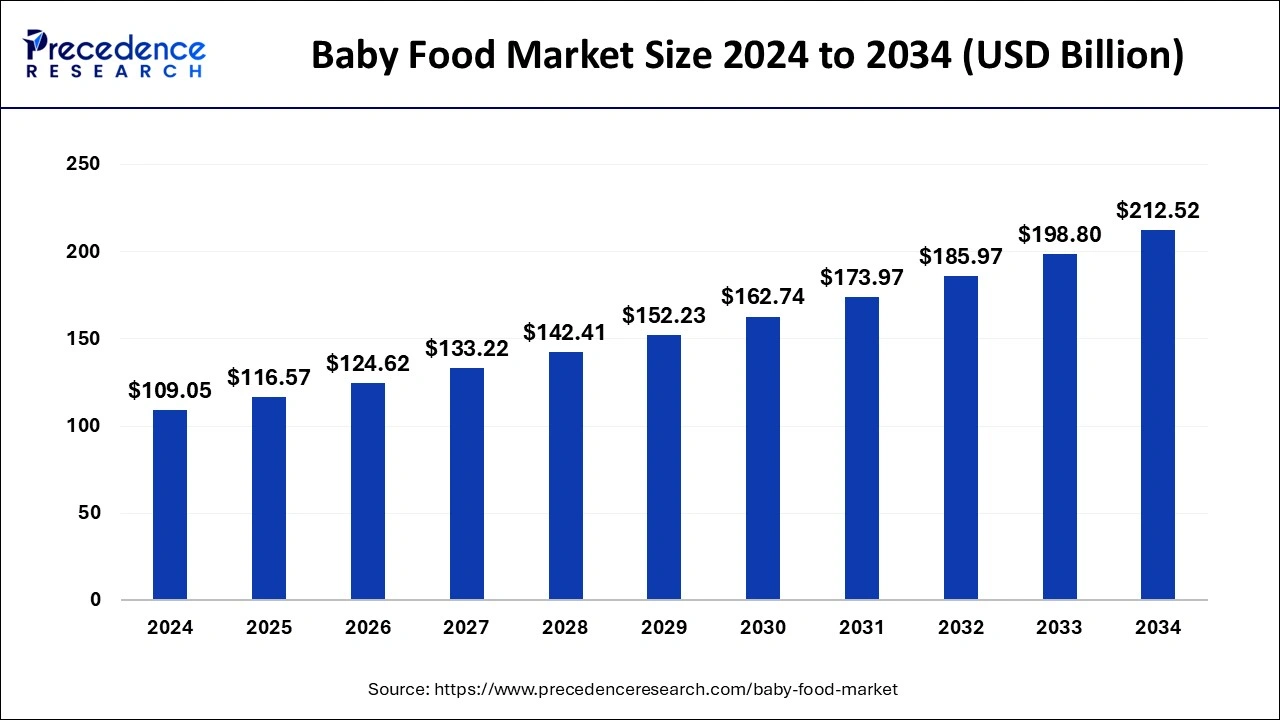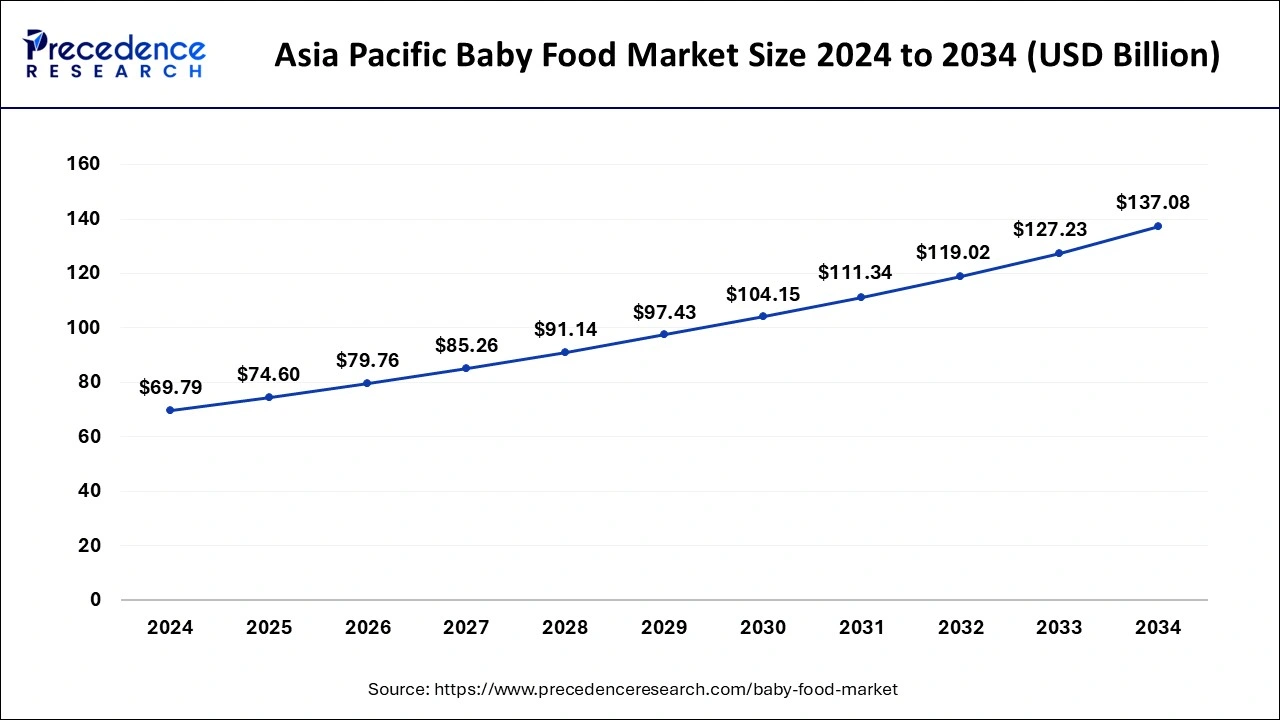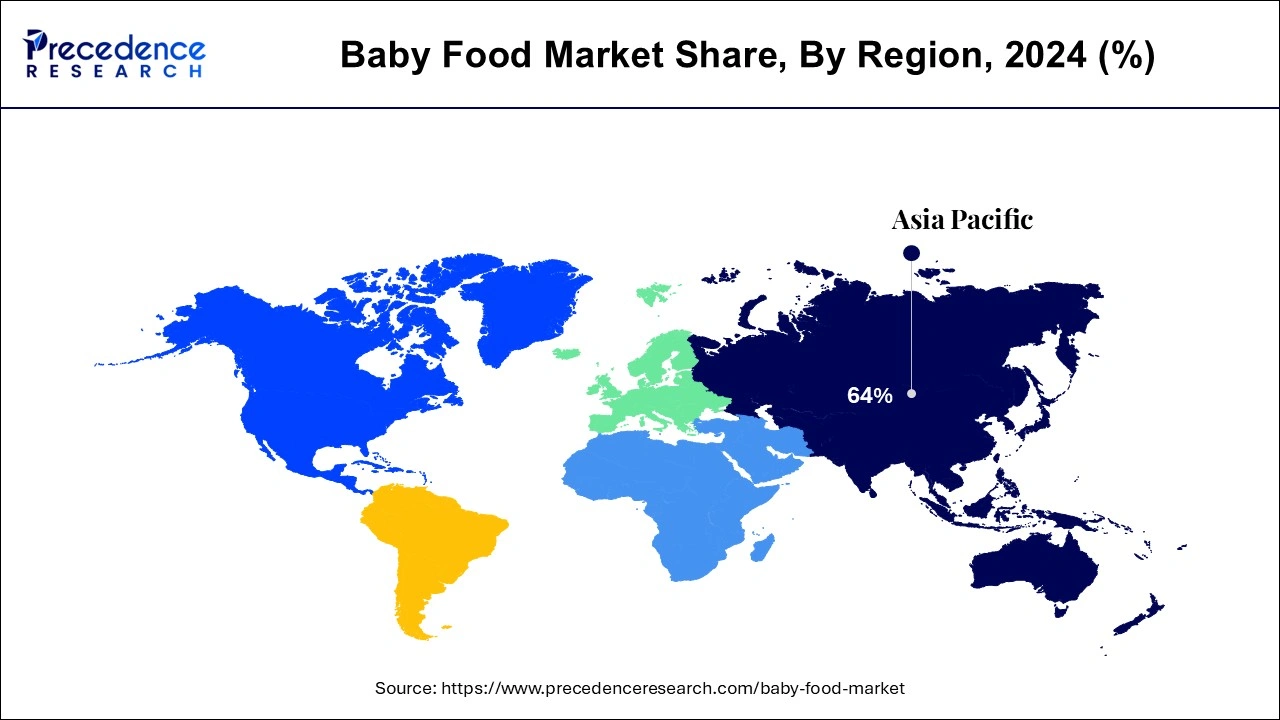February 2025
The global baby food market size is calculated at USD 116.57 billion in 2025 and is forecasted to reach around USD 212.52 billion by 2034, accelerating at a CAGR of 6.9% from 2025 to 2034. The Asia Pacific baby food market size surpassed USD 69.79 billion in 2024 and is expanding at a CAGR of 6.98% during the forecast period. The market sizing and forecasts are revenue-based (USD Million/Billion), with 2024 as the base year.
The global baby food market size was worth around USD 109.05 billion in 2024 and is anticipated to reach around USD 212.52 billion by 2034, growing at a CAGR of 6.9% from 2025 to 2034. This market is proliferating due to increasing awareness regarding the benefits of high-quality baby nutrition requirements.

With the integration of artificial intelligence in the baby food market there is a huge aspect of evolution. It helps to track the market issues associated with baby food and supports better formulation which can add extra benefits for the baby's development. It can detect any ingredient mismatch that can affect the market growth. AI influences market development by gathering consumer reviews that can help in better decision-making and identifying the quality of raw materials. It can detect nutritional benefits required for a baby and help to keep the quality intact. It can also help in developing personalized nutritional plans according to the requirements.
The increased awareness on innovative food products, organized retail marketing activities and increased number of working mothers, decreasing infant mortality rate and increasing parental concerns are all responsible for the growth of this market. During the pandemic, the parents were more conscious about the health of their babies and even though there were lockdowns across the nations the growth in this market has been seen even during the pandemic. In order to provide the infants with organic and healthier supplements and food products, the parents across the world are investing only in these food products. The baby food is soft, easily digestible meal which is created by keeping in mind the human babies aged between 4 to 6 months or up till two years of age.
The Asia Pacific baby food market size was exhibited at USD 69.79 billion in 2024 and is projected to be worth around USD 137.08 billion by 2034, growing at a CAGR of 6.98% from 2025 to 2034.

The Asia Pacific market had the largest revenue in the previous years and it is expected to exhibit promising gains during the forecast period. As there is an increase in the working women population and an awareness of various baby food products that provide the nutrition and ensure the health of the babies the market is expected to grow. Due to diverse distribution options and strong marketing channels, the market shall grow during the forecast.

As a large number of raw material providers for the baby food are present in the European region. Stringent regulations and cutthroat competition among the manufacturers had led to a diversification in the product portfolio and an increase in the nutritional value of the food. The major players are actively engaged in mergers and acquisitions in order to provide a competitive edge. The global players also ensure partnership with the medium,small retailers or enterprise in order to provide the preferred baby food. Lot of revenue is spent on marketing and creating awareness regarding the products that these companies offer. So, the global food market is expected to grow during the forecast.
| Report Coverage | Details |
| Market Size in 2025 | USD 116.57 Billion |
| Market Size by 2034 | USD 212.52 Billion |
| Market Growth Rate from 2025 to 2034 | CAGR of 6.9% |
| Largest Market | Asia Pacific |
| Base Year | 2024 |
| Forecast Period | 2025 to 2034 |
| Segments Covered | Category, Types, Distribution Channel, Ingredients, Formulation, Health Benefit, and Region |
| Regions Covered | North America, Europe, Asia-Pacific, Latin America and Middle East & Africa |
Category Insights
On the basis of category, the baby food market can be segmented into organic and conventional foods. Although the organic baby food is extremely good quality and have more nutrition value, but they are expensive, so this is a setback in the growth for this market. The conventional foods have shown a good growth in the previous years and it is expected to grow during the forecast period.
Type Insights
On the basis of the type of the baby food, the market can be segmented into dried baby food, ready to feed baby food, milk formula, and other types. The ready to eat baby food product accounts for the largest share in terms of revenue. It includes porridge, purees, squash. All these food items are ready to eat. As the number of working women is increasing in the economics across the world, the segment is expected to grow.
Apart from this, the dried food segment, which includes the cereals, fruits and vegetables, should also see a growth during the forecast period. The dried baby food segment is expected to grow at a CAGR of 13% as they have a good shelf life and they are easy to prepare.
On the basis of the distribution channel, the hypermarket or the supermarket segment is expected to have the largest share, in the overall market it happens to have 35% of the total market size. As there is a great awareness and popularity of these food products amongst the people of the Asia Pacific region the supermarkets are expected to grow during the forecast. This segment provides aggressive marketing and lucrative pricing schemes.
Apart from the supermarkets, the online distribution channel is also expected to grow during the forecast. The online distribution channel is expected to have CAGR of 13.2% during the forecast period.
The fats and oils segment dominated the market in 2024. These are highly in demand as fats and oils contain high nutritional value essential for infants. Fats are an important source of energy and play a crucial role in the development of the brain in infants. These are high sources of omega-3 fatty acids which are necessary for cognitive development during the growth period. These fats and oils play a crucial role in the absorption of several vitamins such as vitamins A, D, E, and K.
The powder formula segment dominated the market in 2024. The rising demand for powder formula is due to several reasons such as convenience, nutritional balance, cost-effectiveness, accessibility and various others. These are easy-to-store and hassle-free products which require mixing with water or breast milk while using. Powder formula fulfil all the nutrition required of the baby and it can be created according to individual requirements. These are low-cost solutions which provide the nutrition required for the development of the baby. Powdered formulas are available almost everywhere which makes it more desired among other products.
The muscular development segment dominated the market in 2024. The overall growth of an infant is essential which is the major focus of the market players. There is a rising issue of underweight babies which has enhanced the focus on developing food which can contribute significantly to the development of the muscles. Proper muscle development helps in developing mobility, motor skills, and overall health of the baby.
By Category
By Types
By Distribution Channel
By Ingredients
By Formulation
By Health Benefit
By Geography
For inquiries regarding discounts, bulk purchases, or customization requests, please contact us at sales@precedenceresearch.com
No cookie-cutter, only authentic analysis – take the 1st step to become a Precedence Research client
February 2025
February 2025
January 2025
January 2025